
Dance as an identifying mark in the Réunion and in the West Indies
Dance is one of the ways we celebrate life as humans, a way of being together. These ways of moving our bodies alone or with others to a sound world created by the dancer himself or by musical instruments reflect a way of being in a world that is unique to each culture.
When we look at the lithographs or the travelogues of observers during the time of slavery in the 18th and 19th centuries in French colonies such as Réunion, Martinique and Guadeloupe, we see that European contradances, polka, mazurka and even the Waltz crossed oceans and conquered societies far away from their original stronghold. These dances often recreated themselves locally and developed in all strata of society.
By taking a selection of dances, including maloya, séga, biguine and zouk, we shall see how these choreographic and musical practices were reconstructed locally to then become identity markers. They came about thanks to borrowing, negotiations, and recreations that resulted from individual and/or collective approaches designed to serve and establish an identity.
Réunionese (séga and maloya) and Caribbean dances (biguine and zouk), tinted with European practices reflect the movement of populations who carried a whole range of cultural practices with them, which then spread and mixed with local practices. How then can a dance that is so mixed in terms of its influences claim to be an identity marker of a region?
Dance as a testament to the movement of people
In his thesis on the contradanse from Martinique called "Haute-Taille", anthropologist and ethnomusicologist David Kapoor says how particularly porous the boundaries between social groups of the slave era were, especially in small island territories like Martinique. “Garden” or plantation slaves were able to experience European dances on their voyages to mainland France during which time they were taught their specific work tasks, while "beautiful creole women" were used to serve dance masters. Proximity and the conditions of living as a community, according to him, were two factors that promoted the dissemination of European practices between social classes.
From "primitive séga” to the maloya dance
The séga, tsiega, tchega and even sometimes the t’chega are generic terms used to refer to black dances or black dance tunes in the 18th and 19th centuries in the Indian Ocean.
Maloya slowly took shape over the course of different waves of forced migration during the slave era (1794-1848), from the beginning of French colonization in Réunion up until present today. These forced encounters between peoples from Madagascar, Mozambique and India on Réunionese soil gave rise to cultural practices born from a long dynamic creative process known as: creolization.
The term maloya, which appeared for the first time in a text by Georges Fourcade Z'histoires la case in 1930, became common use after the publication of the first maloya record by Firmin Viri in 1975. Now maloya refers to the dance and music inherited from slaves of African and Malagasy origin. Maloya, which was used not only as a form of entertainment but also in rituals dedicated to the memory of ancestors, was long practised in intimate and family circles (Gramoun Baba and his wife Marie-Marthe Bazaline, Gramoun Liu, and Lo Rwa Kaf, etc...).
The activities of cultural activists like Danyel Waro, Ziskakan but also practitioners of the maloya tradition, such as Gramoun Liu helped to “put maloya in the air”. Since 1 October 2009, it has been listed by UNESCO as part of human heritage, and acknowledged as Réunion’s standard, thereby relegating séga to second place.
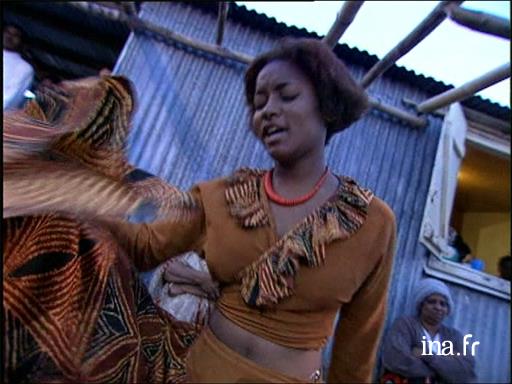
Réunion Island: maloya
Report about maloya, the music of Réunionese slaves, born on sugar cane plantations. It was banned for a good many years.
In Réunion, as in all French territories, slavery was abolished in 1848. But it took decades for the former slaves and their descendants to be able to enjoy all their rights. And even though the Republic gave them their freedom, it also denied them their culture. For a very long time, black Creoles on the island were not allowed to play this type of music. Anyone who played the "roulèr", a type of local drum, was liable to a fine. Maloya was finally authorised in 1981. Since then, old musicians on the island have got out their roulèrs, Nagaras and triangles again. Maloya is very much in fashion, and Granmoun Lélé, Firmin Viry or Daniel Waro have all become stars. Banned until recently, this music of former slaves is now even taught in schools.
Mauritian séga
Mauritian séga ravanne, a term common to the Mascarene Islands in the Indian Ocean, is the equivalent of Réunionese maloya. This practice can actually be found on various islands with various names. We find an equivalent in the Seychelles and in Rodrigues, the moutia and the séga tambour or drum respectively.
Mauritian séga experienced the same difficulties to be accepted in public spaces and was considered an undesirable practice. Despite its very negative connotations, it became popular after the independence of Mauritius in 1968.
Mauritian séga also went by several names: séga ravanne, séga “dans la cour grand case” which was practiced by blacks and people of mixed race who lived closer to the great masters, séga typique, which Tifrèr considered diluted, séga salon, séga moderne and even a more modern form: seggae (a mix of reggae and séga). Like Réunionese maloya from Réunion, it can be seen today being performed in public spaces, on the national and international stage.
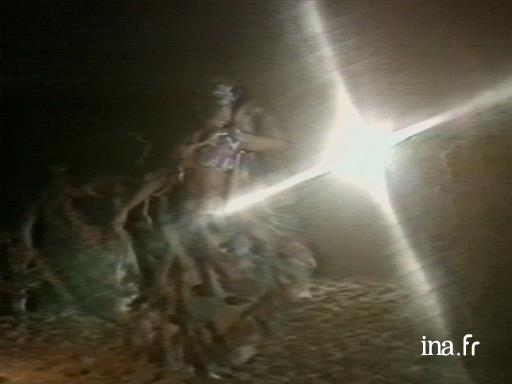
Réunionese séga
A wealth of terminology has been used to describe the different forms of this dance, not all of which have been fully identified; séga primitif or séga national which were danced by slaves, as well as séga créole, described as being "more civilized. This last name refers to a practice whose choreological and musical contours were already well tinted by European influences. This helped to gradually.distinguish maloya séga. In Réunionese séga, couples dance facing each other. There is permanent contact between the dancers whereas this is non-existent in maloya where dancers subtly brush against their partner without ever making real contact. The instruments accompanying séga creole were changed in order to include new European musical instruments such as the accordion and percussion. It also started to use the guitar.
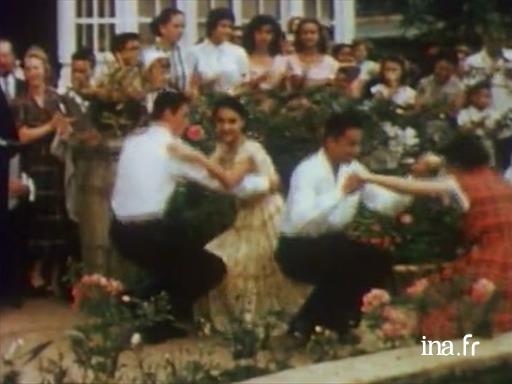
Biguine
The history of biguine also bears witness to the movement of musical and choreographic genres, and indeed the movement of the individuals who transported them.
Biguine, which appeared after the abolition of slavery, was the result of a coming together of European and African cultures (the harmony of the piano came from Europe as pointed out by David Khatile) with those of Martinique and Guadeloupe. From the time of its birth in the Antilles until its significant presence in Paris in the 1930s, biguine was set to conquer Europe and even the world.
The roaring twenties (1920-1938) saw a certain craze for "Negro art". The 1931 colonial exhibition in Paris was a defining moment for renewed Parisian interest for biguine. The Stellio's band, who had come from Martinique to export and increase the notoriety of biguine, could be heard in Montmartre and in the 15th arrondissement of Paris, not far from Montparnasse, at 33 rue Blomet. It was here that all of Paris, hungry for culture and new aesthetics, met up and enjoyed the bal nègre.
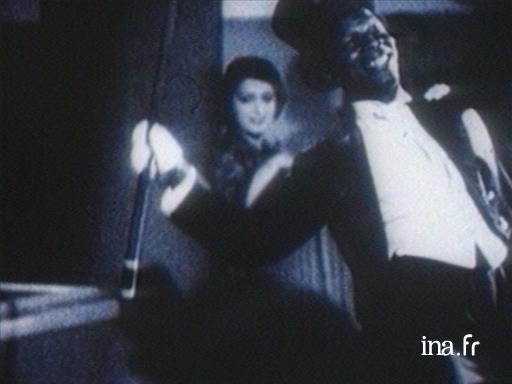
Ernest Leardée or the story of Biguine, history of the bal nègre, rue Blomet
Report about maloya, the music of Réunionese slaves, born on sugar cane plantations. It was banned for a good many years.
In Réunion, as in all French territories, slavery was abolished in 1848. But it took decades for the former slaves and their descendants to be able to enjoy all their rights. And even though the Republic gave them their freedom, it also denied them their culture. For a very long time, black Creoles on the island were not allowed to play this type of music. Anyone who played the "roulèr", a type of local drum, was liable to a fine. Maloya was finally authorised in 1981. Since then, old musicians on the island have got out their roulèrs, Nagaras and triangles again. Maloya is very much in fashion, and Granmoun Lélé, Firmin Viry or Daniel Waro have all become stars. Banned until recently, this music of former slaves is now even taught in schools.
Local reconstruction of dancing practices as an identity strategy
Maloya
With maloya, a number of attempts were made to redefine the dance that people no longer wanted be confused with what they considered its rival: séga. The keepers of this tradition took it on themselves to define its codes.
The "de pat atèr" (with your feet pressed flat on the floor) was chosen to be the element that would distinguish maloya from the séga dance. It is also the name of the album of another maloya singer: Navneet. This expression is well known by Réunionese when referring to maloya. Yet, when we take a closer look, we see that this element is not an established rule. The footwork in maloya is actually very varied. But the recurrence of this movement shows how necessary it was for those who practised it to assert this difference, to honour their identity and their filiations by differentiating themselves. With the re-malagasification of the servis kabaré and maloya dance steps, we saw a reaffirmation of the Malagasy identity, which was done in broad daylight in major musical venues. Maloya inherited steps from old séga, which can be clearly seen in its circular structure, but it also incorporated dancers’ own performance signatures, which helped to redefine the corpus of maloya dance steps. The children of Gramoun Lele personalised their maloya with a papangue dance or fason malgas, and the dancers of the company Artmayage created a contemporary form of maloya, based on maloya tradition. Such is also the very nature of a tradition that persists and evolves over time: to know how to juggle between individual proposals and collective bargaining.
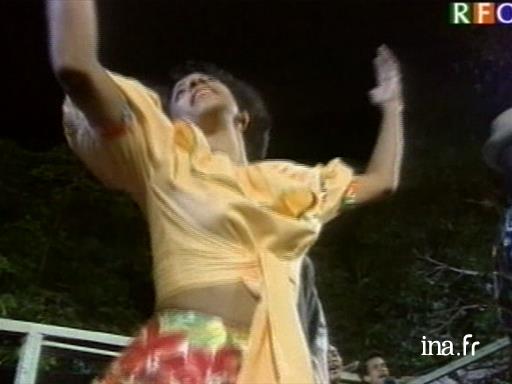
The history of maloya
Presentation of Maloya, a traditional music native to Réunion Island. It is often compared to the blues, and after being censored for many years, it was only officially recognized in 1981. Clips of dancers and singers giving their renditions of rhythms that originated in slavery.
The new Réunionese séga
Today séga in Réunion refers to a genre of music that includes instruments of European origin such as the accordion, guitar, bass, and percussion instruments. When we look at the dance, we find that the Réunionese made a choice between the various figures used in séga in the 1950s. Composed of a range of figures including the candensé, the roulé, the chaloupé and the piké [1], it was above all the chaloupé which can be seen most often during festivities.
This figure is danced with couples holding each other. The dancers are facing each other and are in permanent contact. The male dancer places his right hand on the female dancer’s waist, shoulder blade or back while she holds him. Sometimes dancers who are looking to add a little more diversity in their dance may switch from one figure to another or from one dance step to another, somewhat oblivious to the fact that they are actually practicing a repertoire that was part of an organized logic.
[1] in *Réunionese Saga *, the Creole comrades, June 2015
The dance promotes the development of collective imagination
The arrival of biguine in Paris (and later the zouk) is seen as a real source of joy for the West Indian exiles. «In the dance, we could see the island’s faces, music, rhythm, and language... ". "We would go there to meet up” explains Marie-Madeleine Carbet when talking about dance hall on the rue Blomet.
It was miles away from any segregation, this dance hall where the biguine was so popular with both the Parisians and the Caribbean diaspora alike. It was important for asserting our identity and provided recognition of our identity.
Even if the biguine of dancer Félix Ardinet combined the steps of Charleston (reference to Joséphine Baker), the cane twirls of Fred Astaire with Caribbean dance steps, the audience could still identify with the performances. Because this so characteristic way of moving, the arching of the back, and the interjections used are all familiar elements that belong to and which refresh the memory of Antilles culture.
Zouk
The advent of zouk occurred at the end of the 1970s against a backdrop that was less glorious than that for biguine. Several years after the decolonization of 1946, the overseas French territories were struggling in terms of their economy, people’s health and even food provision. Overcrowding in Réunion, the late development of social policies and the assimilationist and repressive methods used by the French government triggered a number of protests both in Réunion and the Antilles. The French State implemented several initiatives designed to make up for the lack of labour in the aftermath of the Algerian war; but also to remove activists fighting for territorial sovereignty from the French départements.
Jacob Desvarieux, legendary musician in the group Kassav, is a bumidien son. Born in Paris, he grew up in Guadeloupe and Martinique before returning to Marseilles. In Paris, he met Pierre-Edouard Decimus with whom he created Kassav in 1979, the zouk group.
After an initial period of experimentation, it wasn’t until the early 1980s that zouk managed to assert itself as a major musical genre, both in Antilles and among West Indians living in France. Then in 1986 came the true international crowing point that was to project zouk into the world of show business: the group Kassav’s first record to go gold.
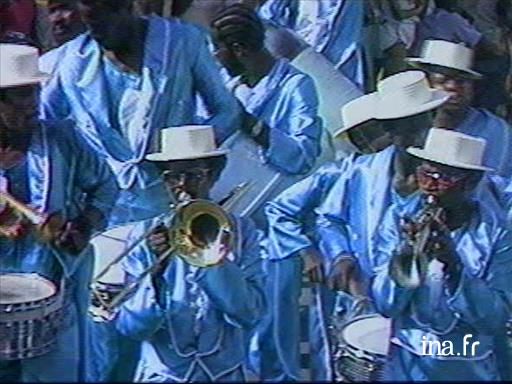
At the time, it was not possible for this collective imagination of the Antilles to take hold with respect to Réunionese music and dance. We could mention the BUMIDOM which, from the beginning of the 60's to the beginning of the 1980s, took more than 1 630 children, some of them barely 3 years old, away from the island. It was difficult for this future diaspora to cultivate memories of traditional practices. This could perhaps explain why Réunionese culture - and in particular maloya and séga - did not enjoy the same reputation in mainland France at this time.
On the other hand, the emergence of maloya did take place on a local level, stimulated by the conjunction of political, social and cultural events. Activists used maloya to carry their music and the creole language as a means of asserting and imposing their Réunionese identity. Maloya thus conquered all the social and ethnic classes, both in Réunion and throughout the world.
In Réunion and in the Antilles, the practices of slaves and their descendants including maloya, séga, biguine and zouk were constructed by borrowing from other cultures, or through creations resulting from individual initiatives and collective bargaining. This dynamic creative process called “creolization” can be seen throughout history and still continues to evolve today. It is thanks to the initiatives of individuals that these practices are being redefined to assert a collective identity that makes sense for the people who hold it dear. The diaspora who spread throughout the world carried their music and their dance with them, which they then recreated in their new home at a local level.





